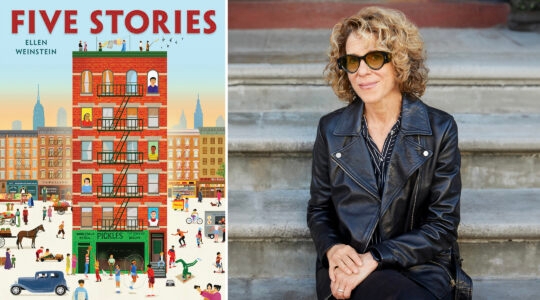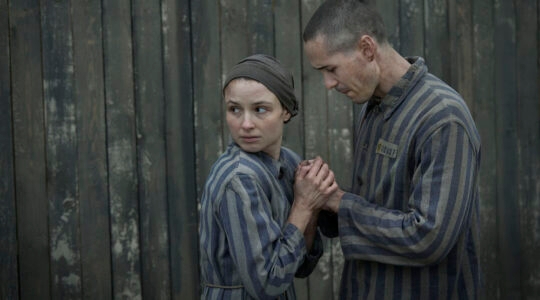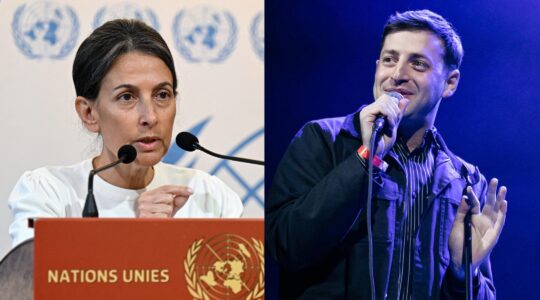MOSCOW, Dec. 12 (JTA) — Max Penson has made a comeback nearly a half-century after his death.
At the height of his fame, the Jewish photojournalist’s work appeared often on the front pages of Soviet newspapers. One of his pictures took a top prize at the 1937 World’s Fair in Paris.
But Penson fell victim to the growing anti-Semitism of Josef Stalin’s totalitarian regime, lost his job and spent the rest of his life suffering from illness and depression.
When he died in 1959, it seemed his work was doomed to languish in obscurity.
Even Penson’s oldest son didn’t realize the value of the old negatives stored in his apartment in Tashkent, Uzbekistan.
“I had no idea of the significance of my father’s archive,” said Miron Penson, 79, who lives in New York.
After being approached by a Swiss collector in 1997, however, Penson realized he was sitting on a treasure trove, and in the decade since then, he and his siblings have fueled a revival of interest in their father’s work.
Combing through his archive, they have uncovered images of Central Asia from the 1920s and 1930s that have gone on display in Moscow, Paris and London.
The latest exhibition of Max Penson’s photography opened recently in London’s Somerset House. Its photographs reflect the overarching theme of Penson’s career: the transformation of Uzbekistan from a deeply traditional Muslim society into a Soviet republic.
In one picture, cotton workers plow the fields of a newly created collective farm. In other works, Penson focuses on kindergartners and uniformed soldiers on parade. Many of the photos feature the trademark angular style of Constructivism made famous by Soviet propaganda and movie posters of the 1920s.
Olga Sviblova, a Moscow art specialist who curated the exhibit, believes that Penson should be ranked with the leading Soviet photographers of his era, such as Constructivism pioneer Alexander Rodchenko.
“I think Rodchenko was a visionary and a genius,” she said. “But if you evaluate them purely on the basis of their photography, Penson is the better photographer.”
Penson has acquired some influential friends. Billionaire Roman Abramovich sponsored the catalog for the exhibition, which carries the somewhat redundant title “Classic Soviet Modernist Photographer Max Penson and the Soviet Modernization of Uzbekistan 1920s-1930s.”
Penson came to Uzbekistan as something of an outsider. He was born in 1893 to a Jewish family in a small town outside Vitebsk, a city in present-day Belarus. Vitebsk was also the birthplace of painter Marc Chagall, and in fact, Miron Penson suspects that his father and Chagall knew each other, since both studied drawing and painting from an early age.
But in 1915, to escape the pogroms of World War I, Penson and his family fled to Asia. They settled in Kokand, a city in eastern Uzbekistan, where Penson taught drawing at a local school. He later moved to Tashkent.
It was about that time he was given his first camera, which proved to be a life-changing event.
In 1926, he became a photographer for the newspaper Pravda Vostoka, where his main task was to document the radical changes taking place in Central Asia.
Following peasant literacy campaigns and touring vast construction projects, Penson took photos that were circulated around the Soviet Union by the Tass news agency. His best-known image — a portrait called “Uzbek Madonna,” which won top honors at the 1937 World’s Fair — shows a liberated, unveiled Muslim woman breast-feeding her infant.
Miron Penson remembers his father as a tireless worker who stayed awake late at night developing his photographs. Director Sergei Eisenstein, who met Max Penson in 1940 while shooting a film about the digging of the Grand Fergana Canal, also recalled the photographer’s boundless energy.
But Penson could not escape the dark side of Soviet rule. The demands of Socialist Realism, the official artistic ideology of the Soviet Union, forced him to produce fewer closeups of expressive faces and more images of people celebrating the cult of Lenin and Stalin.
“Socialist Realism made him do things he didn’t want to do,” Miron Penson said.
In his memoir, Miron Penson also recalls how his father would light small fires in the courtyard of their house, burning photographs of people who had been arrested and charged as “enemies of the people.”
Eventually, it came to be Max Penson’s turn. The years 1948 and 1949 brought a wave of anti-Semitism to the Soviet Union, which had once seemed like a land of opportunity to Jews like Penson who had fled the pogroms and religious restrictions of the Russian Empire.
In 1949, without explanation, his license to work as a photojournalist was revoked by Stalin’s secret police, the NKVD. The move effectively ended his career.
Unable to work, Penson became withdrawn and suffered increasingly from ill health. During his last years he spent much of his time retouching his old photos, occupied with a bizarre, repetitive and seemingly pointless task in which he rubbed out people’s eyes and gave them new ones.
Following his death, Max Penson’s work was largely forgotten in the Soviet Union. His archive remained a family possession, but it was nearly wiped out when Tashkent was struck by a major earthquake in 1966. The surviving negatives were pulled from the rubble by his daughter, Dina, and her husband.
Max Penson’s two sons, Edik and Miron, both became photographers. Miron Penson also achieved success as a cinematographer at Uzbekfilm, the main film studio of Uzbekistan. He immigrated to the United States in 1999.
Asked to compare his photography to that of his father, Miron Penson simply laughs.
“I can’t compare them,” he said. “We are people of completely different eras.”
New focus on Soviet-era photographer
Advertisement





